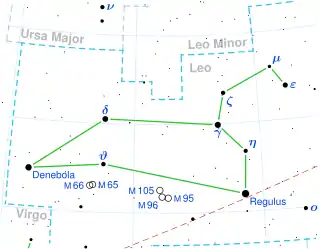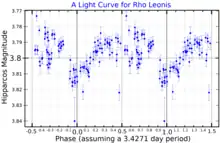 | |
| Observation data Epoch J2000 Equinox J2000 | |
|---|---|
| Constellation | Leo |
| Right ascension | 10h 32m 48.67168s[1] |
| Declination | +09° 18′ 23.7094″[1] |
| Apparent magnitude (V) | 3.83 - 3.90[2] |
| Characteristics | |
| Spectral type | B1 Iab[3] |
| U−B color index | −0.945[4] |
| B−V color index | −0.153[4] |
| Variable type | α Cyg[2] |
| Astrometry | |
| Radial velocity (Rv) | +42.0[5] km/s |
| Proper motion (μ) | RA: −5.93±0.20[1] mas/yr Dec.: −3.40±0.11[1] mas/yr |
| Parallax (π) | 0.60 ± 0.18 mas[1] |
| Distance | approx. 5,000 ly (approx. 1,700 pc) |
| Absolute magnitude (MV) | −6.02[6] |
| Details | |
| Mass | 27.1±8.4[7] M☉ |
| Radius | 37.4[8] R☉ |
| Luminosity | 45,604[9] L☉ |
| Surface gravity (log g) | 1.18[9] cgs |
| Temperature | 22,000[9] K |
| Metallicity [Fe/H] | −0.06[10] dex |
| Rotation | 7±2 d[11] |
| Rotational velocity (v sin i) | 49[12] km/s |
| Age | 4.5±0.1[7] Myr |
| Other designations | |
| Database references | |
| SIMBAD | data |
Rho Leonis (ρ Leo) is a binary star in the zodiac constellation of Leo, and, like the prominent nearby star Regulus, is near the ecliptic. With an apparent visual magnitude of 3.9,[4] this star can be readily seen with the naked eye. Parallax measurements give a distance estimate of about 5,400 light-years (1,700 parsecs) from the Earth.[13] Rho Leonis is an Alpha Cygni-type variable star, showing 0.032 magnitude brightness variations with a period of 3.427 days, in Hipparcos data.[14]

This is an enormous star with about 21 times the Sun's mass (M☉)[16] and 37 times the Sun's radius.[8] Its spectrum matches a stellar classification of B1 Iab,[3] with the 'Iab' luminosity class indicating that it is in the supergiant stage of its evolution. Rho Leonis is radiating about 45,000 times the Sun's luminosity at an effective temperature of 22,000 K,[9] giving it the blue-white hue typical of a B-type star. A strong stellar wind is expelling mass from the outer envelope at a rate of 3.5×10−7 M☉ per year, or the equivalent of 1 M☉ every 2.8 million years.[8] The rotation rate is probably about once per 7 days, with an upper limit of 47 days.[11]
Rho Leonis is classified as a runaway star, which means it has a peculiar velocity of at least 30 km s−1 relative to the surrounding stars. It has radial velocity of 42 km s−1 away from the Sun and a proper motion that is carrying it about 1.56 Astronomical Units per year, equivalent to 7 km s−1,[17] in a transverse direction. The star is situated about 2,300 light-years (710 parsecs) above the galactic plane.[18]
Rho Leo is 0.15 degree north of the ecliptic, so it can be occulted by the moon. Unusual light variation during these occultations has been explained as the result of a possible close companion. The companion would be just over one magnitude fainter and separated by 0.01 arcsec.[19] The companion has not been detected by any other means although it should be easily detected with modern observations.[20]
References
- 1 2 3 4 5 van Leeuwen, F. (November 2007). "Validation of the new Hipparcos reduction". Astronomy and Astrophysics. 474 (2): 653–664. arXiv:0708.1752. Bibcode:2007A&A...474..653V. doi:10.1051/0004-6361:20078357. S2CID 18759600.
- 1 2 Samus, N. N.; Durlevich, O. V.; et al. (2009). "VizieR Online Data Catalog: General Catalogue of Variable Stars (Samus+ 2007-2013)". VizieR On-line Data Catalog: B/GCVS. Originally Published in: 2009yCat....102025S. 1. Bibcode:2009yCat....102025S.
- 1 2 Lesh, Janet Rountree (December 1968). "The Kinematics of the Gould Belt: an Expanding Group?". Astrophysical Journal Supplement. 17: 371. Bibcode:1968ApJS...17..371L. doi:10.1086/190179.
- 1 2 3 Gutierrez-Moreno, Adelina; et al. (1966). "A System of photometric standards". Publ. Dept. Astron. Univ. Chile. 1: 1–17. Bibcode:1966PDAUC...1....1G.
- ↑ Wilson, Ralph Elmer (1953). "General Catalogue of Stellar Radial Velocities". Washington. Bibcode:1953GCRV..C......0W.
- ↑ Melnik, A. M.; Dambis, A. K. (2020). "Distance scale for high-luminosity stars in OB associations and in field with Gaia DR2. Spurious systematic motions". Astrophysics and Space Science. 365 (7): 112. arXiv:2006.14649. Bibcode:2020Ap&SS.365..112M. doi:10.1007/s10509-020-03827-0. S2CID 220128144.
- 1 2 Tetzlaff, N.; Neuhäuser, R.; Hohle, M. M. (January 2011). "A catalogue of young runaway Hipparcos stars within 3 kpc from the Sun". Monthly Notices of the Royal Astronomical Society. 410 (1): 190–200. arXiv:1007.4883. Bibcode:2011MNRAS.410..190T. doi:10.1111/j.1365-2966.2010.17434.x. S2CID 118629873.
- 1 2 3 Kraus, M.; Borges Fernandes, M.; Kubát, J. (May 2009). "Parameters of galactic early B supergiants. The influence of the wind on the interstellar extinction determination". Astronomy and Astrophysics. 499 (1): 291–299. Bibcode:2009A&A...499..291K. doi:10.1051/0004-6361/200810319.
- 1 2 3 4 Georgy, Cyril; Saio, Hideyuki; Meynet, Georges (2021). "Blue supergiants as tests for stellar physics". Astronomy and Astrophysics. 650: A128. arXiv:2104.06278. Bibcode:2021A&A...650A.128G. doi:10.1051/0004-6361/202040105. S2CID 233219422.
- ↑ Koleva, M.; Vazdekis, A. (2012). "Stellar population models in the UV. I. Characterisation of the New Generation Stellar Library". Astronomy & Astrophysics. 538: A143. arXiv:1111.5449. Bibcode:2012A&A...538A.143K. doi:10.1051/0004-6361/201118065. S2CID 53999614.
- 1 2 Kholtygin, A. F.; et al. (November 2007). "Microvariability of line profiles in the spectra of OB stars: III. The supergiant ρ LEO". Astronomy Reports. 51 (11): 920–931. Bibcode:2007ARep...51..920K. CiteSeerX 10.1.1.618.7621. doi:10.1134/S1063772907110054. S2CID 121575654.
- ↑ Simón-Díaz, S.; Herrero, A. (2014). "The IACOB project. I. Rotational velocities in northern Galactic O- and early B-type stars revisited. The impact of other sources of line-broadening". Astronomy and Astrophysics. 562: A135. arXiv:1311.3360. Bibcode:2014A&A...562A.135S. doi:10.1051/0004-6361/201322758. S2CID 119278062.
- ↑ Perryman, M. A. C.; et al. (July 1997). "The HIPPARCOS Catalogue". Astronomy & Astrophysics. 323: L49–L52. Bibcode:1997A&A...323L..49P.
- ↑ Lefèvre, L.; Marchenko, S. V.; Moffat, A. F. J.; Acker, A. (November 2009). "A systematic study of variability among OB-stars based on HIPPARCOS photometry". Astronomy and Astrophysics. 507 (2): 1141–1201. Bibcode:2009A&A...507.1141L. doi:10.1051/0004-6361/200912304.
- ↑ "Light Curve". Hipparcos ESA. ESA. Retrieved 17 February 2022.
- ↑ Conlon, E. S.; et al. (September 1990). "The runaway nature of distant early-type stars in the galactic halo". Astronomy and Astrophysics. 236 (2): 357–361. Bibcode:1990A&A...236..357C.
- ↑ An Astronomical Unit (AU) is 1.5 × 108 km, while a year is 3.2 × 107 seconds. Thus, 1.56 AU/year = (1.56 AU/yr) × (1.5 × 108 km/AU) / (3.2 × 107 s/yr) = 7 km/s.
- ↑ Lauroesch, J. T.; Meyer, David M. (July 2003). "Variable Na I Absorption toward ρ Leonis: Biased Neutral Formation in the Diffuse Interstellar Medium?". The Astrophysical Journal. 591 (2): L123–L126. arXiv:astro-ph/0306005. Bibcode:2003ApJ...591L.123L. doi:10.1086/377164. S2CID 119356147.
- ↑ Radick, R. R.; Africano, J. L.; Flores, M. R.; Klimke, D. A.; Tyson, E. T. (1982). "Cloudcroft occultation summary. II - April 1980-December 1981". The Astronomical Journal. 87: 1874. Bibcode:1982AJ.....87.1874R. doi:10.1086/113277. ISSN 0004-6256.
- ↑ McAlister, H. A. (1978). "Binary stars unresolved by speckle interferometry". Publications of the Astronomical Society of the Pacific. 90: 288. Bibcode:1978PASP...90..288M. doi:10.1086/130327. ISSN 0004-6280.
External links
- Kaler, James B., "Rho Leonis", Stars, University of Illinois, retrieved 2012-01-11